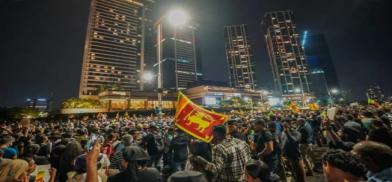Where is the roadmap to restore Sri Lanka's glory?
Today, Sri Lanka needs the Singapore model of governance where the stick and carrot policy is elegantly used, with citizens living with confidence in the government about maintaining law and order and fair play

Most people in the world, whether Sri Lankans or otherwise, are concerned about the present plight of the island nation due to an economic collapse and consequent unrest amongst the people.
Several experts and observers have commented liberally as to how this country with beautiful landscape and glorious culture has been reduced to this state. The diagnosis is complete. But it appears that the process of evolving a prescription to overcome the crisis is yet to be convincingly evolved and crystallized.
At present, the focus is on getting loan or aid from abroad as if this by itself could sort out the grim issues facing Sri Lanka.
Sri Lanka already has a huge debt to service and repay and its government has said that it cannot pay the debt or interest at the present stage and admitted that it is a defaulter.
With a huge debt on its head and with more loan being availed now, it is urgently necessary that a credible roadmap to overcome the present crisis has to be prepared, discussed and a firm decision should be taken which should be implemented in a time bound manner.
Outline roadmap
While there is news about mass agitation and the demand by the opposition and activists that both the President and the Prime Minister should quit, what is conspicuous by absence is that neither the government nor the opposition parties or the activists have suggested a credible roadmap to bring the focus of debate on economic and industrial revival.
The ground reality today in Sri Lanka is that the Rajapaksa brothers have mismanaged the economy. It appears that the opposition leaders, some of who have already been in the government and failed, too do not command widespread public confidence that they have the capability and expertise to lead Sri Lanka to restore its glory anytime soon.
In such circumstances, the emerging view seems to be that a mere change of President or Prime Minister will not bring about any change for the better.
The suggestion of the President of Sri Lanka that a national government should be formed (perhaps, without the present Prime Minister), appears to be an appropriate solution at this critical stage. After one year of governance by such a national government, which will commence implementation of a roadmap and restore confidence amongst the people, a national election can take place.
While Sri Lanka does not have resources such as crude oil and natural gas which are now considered very valuable asset for any country, there are many other strengths the country has and the options for reviving the national economy are many.
Way ahead
Agriculture sector contributes about 7.4 percent to the national GDP, out of which the fisheries sector contributes around 1.3 percent and the livestock sector 0.9 percent. With regard to tea and rubber, Sri Lanka is a significant exporter and its products enjoy world reputation.
Although Sri Lanka is a fertile tropical land with the potential for cultivation and processing of a variety of crops, issues such as productivity hamper the growth of the sector. With focussed agricultural management adopting modern technologies, Sri Lanka can be made nearly self-sufficient in food production.
Technology inputs from developed countries will be much needed.
Sri Lanka is endowed with a variety of mineral resources such as feldspar, clays (including ball clay and kaolin), dolomite, graphite, limestone, mica, mineral sands (including ilmenite, rutile, and zircon), phosphate rock, quartzite and salt. There are many exciting opportunities in this area where overseas investment and technology can be invited for mutual benefit.
In Sri Lanka, due to its vast coast, there could be many opportunities in the production of marine chemicals and launching research efforts in marine biology. Many multinational players will be interested in participating in such ventures.
Of course, tourism is a big thrust area for Sri Lanka where it has already made a mark. There are several innovative projects possible to boost tourism.
Many similar examples of growth opportunities can be readily pointed out.
Singapore way
Sri Lanka needs to have a progressive and forward-looking policy with stress and focus on international cooperation to promote rapid industrial and technological growth.
Today, Sri Lanka needs the Singapore model of governance where the stick and carrot policy is elegantly used, with citizens living with confidence in the government vis-a-vis law and order and fair play.
One problem for Sri Lanka, like other nearby countries, is an excessive level of democracy without adequate checks and controls, which is doing more harm than good.
The people of Sri Lanka and the politicians should realize that liberty to state their views and indulge in protests cannot be a mere personal affair but it has to be a part of social contract coupled with responsible attitude.
The sad fact is that there have been lot of corruption allegations in Sri Lanka for which the Rajapaksa government is responsible to some extent, and particularly since Rajapaksa has made the government virtually a family affair.
(The writer is a Trustee, NGO Nandini Voice for the Deprived, Chennai. Views are personal. He can be contacted at nsvenkatchennai@gmail.com)









Post a Comment